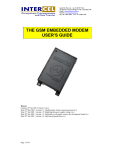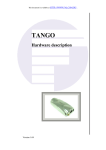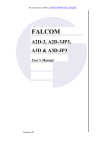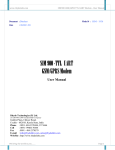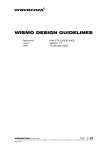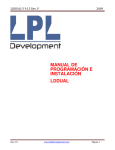Download THE GSM EMBEDDED MODEM USER'S GUIDE
Transcript
InterCEL Pty. Ltd. A.C.N. 007 077 161 33 Glenvale Crescent Mulgrave VIC. Australia 3170 Email : [email protected] Internet : www.intercel.com.au Ph: +61 3 9561 1666 Fax: +61 3 9561 2614 THE GSM EMBEDDED MODEM USER’S GUIDE History: Version 1.3 Created: 10th Oct 2001 Author: Sang Vu Date 28th Mar 2002: Version 1.1 Modifying the 44-pin connector pinouts Date 11th Jun 2002: Version 1.2 Modifying the power supply voltage Date 25th Jun 2002: Version 1.3 Add details to all signals, remove the development board Confidential Page 1 25/06/2002 InterCEL Pty. Ltd. A.C.N. 007 077 161 33 Glenvale Crescent Mulgrave VIC. Australia 3170 Email : [email protected] Internet : www.intercel.com.au Ph: +61 3 9561 1666 Fax: +61 3 9561 2614 Contents 1 Introduction 3 1.1 1.2 1.3 1.4 Scope of this manual Electrical characteristics Mechanical characteristics Features 1.4.1 Telephony 1.4.2 Short Message Service 1.4.3 Data 1.4.4 GPRS packet data features 1.4.5 GSM Supplementary Service 1.4.6 Others 1.5 Interfaces 2 RF Safety 2.1 2.2 2.3 2.4 General Exposure to RF energy Efficient modem operation RF interference 3 Standard Compliance 5 6 3.1 3.2 3.3 3.4 GSM Phase II compliance Safety compliance EMC compliance FTA compliance 3.4.1 IMEI number 3.4.2 CE label 3.5 ACA compliance 4 RF specifications 7 4.1 RF architecture 4.2 RF frequency 4.3 RF performance 4.3.1 Receiver 4.3.2 Transmitter 5 Hardware Description 8 5.1 Overview 5.2 The 44 pin connector 5.3 Signal descriptions 5.3.1 Power supply 5.3.2 SPI bus 5.3.3 Keypad interface 5.3.4 Serial link 5.3.5 SIM interface 5.3.6 General-Purpose Input/ Output 5.3.7 Audio 5.3.8 Buzzer output 5.3.9 Control signals 5.3.10 Real-time clock supply Confidential Page 2 25/06/2002 InterCEL Pty. Ltd. A.C.N. 007 077 161 33 Glenvale Crescent Mulgrave VIC. Australia 3170 Email : [email protected] Internet : www.intercel.com.au Ph: +61 3 9561 1666 Fax: +61 3 9561 2614 1 Introduction The GEM is designed to provide a quick and easy solution to systems that need to access GSM/GPRS network/functionality. The modem is full type approved and ready to use. It employs the proven GSM WISMO™ technology from WAVECOM. 1.1 Scope of this manual This document describes the hardware interface and the technical specification of the GEM. For information about controlling the modem via the AT commands, refer to the ‘ AT command manual’. 1.2 Electrical characteristics • • • • • • • • • • • Dual band GSM modem E-GSM 900/1800 or E-GSM 900/1900 Class 4: 2W for GSM 900 Class 1: 1W for GSM 1800/1900 Voice, SMS, Fax and data Tricodec: Full Rate, Enhanced Full Rate and Half Rate 3V SIM interface Power supply: 3.6V to 4.2V @ 2A 300mA average current consumption 9mA in idle mode Operating temperature: -20°C to + 55°C Storage temperature: -35°C to +85°C 1.3 Mechanical characteristics • • • • Small size: 62mm(L) x 38mm(W) x 12mm(H) Weight: 25g Casing: ABS Plastic Mounting: 3 screw holes 1.4 Features 1.4.1 • • • Telephony (TCH/FS) and Emergency calls Full Rate, Enhanced Full Rate and Half Rate DTMF functions 1.4.2 • • Short Message Service Point to Point MT and MO SMS Cell Broadcast 1.4.3 • • • • Telephony Data Data circuit asynchronous, transparent and non-transparent up to 14.4kbps Automatic fax group 3 (Class 1 and Class2) Alternate speech and fax MNP2, V.42bis Confidential Page 3 25/06/2002 InterCEL Pty. Ltd. A.C.N. 007 077 161 33 Glenvale Crescent Mulgrave VIC. Australia 3170 Email : [email protected] Internet : www.intercel.com.au Ph: +61 3 9561 1666 Fax: +61 3 9561 2614 1.4.4 • • • GPRS class 2 / Class B (2Rx/1Tx, GSM/GPRS switchable) Coding schemes CS1 to CS4 Compliant with SMG31bis 1.4.5 • • • • • • • • • GSM Supplementary Service Call Forwarding Call Barring Multi Party Call Waiting and Call Hold Calling Line Identity Advice of Charge USSD Closed User Group Explicit Call Transfer 1.4.6 • • • • • • • • GPRS packet data features Others ME + SIM phone book management Fixed Dialling Number SIM Toolkit Class 2 SIM, network and service provider locks Real Time Clock Alarm management Software upgrade through Xmodem protocol UCS2 character set management 1.5 Interfaces • • • • Single Antenna Interface 3V only internal SIM interface 44-pin general purpose connector Serial RS-232C link: 300bps to 115200 bps Confidential Page 4 25/06/2002 InterCEL Pty. Ltd. A.C.N. 007 077 161 33 Glenvale Crescent Mulgrave VIC. Australia 3170 Email : [email protected] Internet : www.intercel.com.au Ph: +61 3 9561 1666 Fax: +61 3 9561 2614 2 RF safety 2.1 General The GEM is based on the GSM standard for cellular technology. It is a low power radio transmitter and receiver. It sends and receives radio frequency energy. The GEM radio frequency and transmit power levels are controlled by the cellular system. 2.2 Exposure to RF energy There has been some public concern about possible health effects of using GSM modem. After all existing researches have been reviewed and all applicable safety standards have been met, the modem is fitted for use. If exposure to RF energy is still the main concern, there are ways to minimize the exposure: Positioning the antenna and limitting the duration of the calls. 2.3 Efficient modem operation For the modem to operate at the lowest power level, use the correct antenna and place the antenna at the position where it gets the best possible signal strength. Do not hold the antenna while the modem is in a call. 2.4 RF interference Most of the electronic equipments are shielded against RF energy. However, RF energy may affect some equipment that is inadequately shielded. To use the modem near particular electronic equipment, check with the manufacturer’s shielding specifications. Confidential Page 5 25/06/2002 InterCEL Pty. Ltd. A.C.N. 007 077 161 33 Glenvale Crescent Mulgrave VIC. Australia 3170 Email : [email protected] Internet : www.intercel.com.au Ph: +61 3 9561 1666 Fax: +61 3 9561 2614 3 Standard Compliance The GEM modem meets the following standards 3.1 GSM Phase II compliance • • • • EN 301 419-1, (GSM 13.01) April 2000, Version 4.1.1 EN 301 420 (GSM 13.02) December 1999, Version 4.0.1 ETS 300 607-1, (GSM 11.10-1) September 2000, Version 4.28.1 GT.01, December 2000, Version 4.7.0 3.2 Safety • EN 60950: 2000 (3rd edition) : Safety of information technology equipment 3.3 EMC • • • • EN 301 489-7: 2000 EN 301 489-1: 2000 EN 50081-1: 1992 EN50082-1: 1997 3.4 FTA compliance The GEM has received a Full-Type approval (according to normal MS requirements) in the configuration using the internal SIM interface. 3.4.1 • • • IMEI number TAC: 500246 FAC: 66 Serial number: 000000 to 999999 3.4.2 CE label The GEM is CE compliant, which implies that the modem is in conformity with the European Community directives and bears the CE label CE0681 3.5 ACA compliance The modem has been declared to be ACA compliant. It bears the A-tick mark and C-tick mark, which enables it to be used in Australia and New Zealand Confidential Page 6 25/06/2002 InterCEL Pty. Ltd. A.C.N. 007 077 161 33 Glenvale Crescent Mulgrave VIC. Australia 3170 Email : [email protected] Internet : www.intercel.com.au Ph: +61 3 9561 1666 Fax: +61 3 9561 2614 4 RF specifications 4.1 RF architecture The RF part is based on a specific dual band chip and includes: • • • • • • 2 dedicated down converters IF demodulator All local RF & IF VCO PLL Transmit loop (modulator, down mixer, phase frequency comparator) 2 power amplifiers 4.2 RF frequencies The RF functionalities comply with the Phase II EGSM 900/GSM 1800 or GSM 1900 recommendation: • • Rx (EGSM): 925 to 960MHz Tx (EGSM): 880 to 915MHz • • Rx (GSM 1800): 1805 to 1880MHz Tx (GSM 1800): 1710 to 1785MHz • • Rx (GSM 1900): 1930 to 1990MHz Tx (GSM 1900): 1850 to 1910MHz 4.3 RF performances 4.3.1 • • • • • • EGSM 900 sensitivity: < -102 dBm GSM 1800/1900 sensitivity: <-102 dBm Selectivity @ 200 KHz: > 9 dBc Selectivity @ 400 KHz: > 41 dBc Dynamic range: > -43 dBm Co-channel rejection: >= 9 dBc 4.3.2 • • • • • • • • Receiver Transmitter Maximum output power for EGSM 900: 33dBm ± 2dB Maximum output power for GSM 1800/1900: 30dBm ± 2dB Minimum output power for EGSM 900: 5dBm ± 5dB Minimum output power for GSM 1800/1900: 0dBm ± 2dB H2 level: < -30 dBm H3 level: < -30 dBm Phase error at peak power: <5° RMS Frequency error: ± 0.1 ppm max Confidential Page 7 25/06/2002 InterCEL Pty. Ltd. A.C.N. 007 077 161 33 Glenvale Crescent Mulgrave VIC. Australia 3170 Email : [email protected] Internet : www.intercel.com.au Ph: +61 3 9561 1666 Fax: +61 3 9561 2614 5 Hardware Description 5.1 Overview The GEM includes a Wavecom Wismo3 module, a 44-pin header, a SIM-card holder and a RF connector. Pin1 Pin2 Pin43 Pin44 Figure 1: Modem bottom view SIM card Figure 2: Modem Top view MMCX antenna connector Figure 3 : Modem side view - Modem connector : Samtec 44-pin high density Antenna connector: MMCX Confidential Page 8 25/06/2002 InterCEL Pty. Ltd. A.C.N. 007 077 161 33 Glenvale Crescent Mulgrave VIC. Australia 3170 Email : [email protected] Internet : www.intercel.com.au Ph: +61 3 9561 1666 Fax: +61 3 9561 2614 5.2 The 44-pin connector This connector consists of all signals, necessary for system integration. It consists of serial RS232 signals, audio input/output, general I/O, keypad, power supply and modem control signals. Pin number I/O type Description 1 2 3 4 5 6 7 8 9 10 11 12 13 14 15 16 17 18 19 20 21 22 23 24 25 26 27 28 29 30 31 32 33 34 35 36 37 38 39 40 41 42 43 44 GND ON/OFF GND RESET AUXV0 BUZZER MIC2+ SPEAKER2+ MIC2SPEAKER2RTS DTR RXD DSR TXD CTS DCD RI BOOT GPIO4 VCC_RTC GPIO5 GPIO0 LED SIM_PRES SIM_DATA SIM_CLK SIM_RESET SIM_VCC SPI_CLK SPI_EN SPI_IO Key_Row0 Key_Column0 Key_Row1 Key_Column1 Key_Row2 Key_Column2 Key_Row3 Key_Column3 Key_Row4 Key_Column4 3V6 3V6 Ground, high current Input, modem on/off control signal Ground, high current Input, modem reset control signal Analogue input signal Buzzer output Microphone2, positive input Speaker2, positive output Microphone2 negative input Speaker2, negative output RS232 interface, input RS232 interface, input RS232 interface, output RS232 interface, output RS232 interface, input RS232 interface, output RS232 interface, output RS232 interface, output Input control signal General Purpose input/Output 4 Supply voltage to Real-Time clock General Purpose input/Output 5 General Purpose input/Output 0 Output, Working Indication Input, SIM card detect I/O , SIM data Output, SIM clock Output, SIM reset Output, SIM card supply voltage Output, SPI clock Output, SPI enable I/O, SPI data I/O, Keypad Row 0 I/O, keypad Column 0 I/O, Keypad Row 1 I/O, keypad Column 1 I/O, Keypad Row 2 I/O, keypad Column 2 I/O, Keypad Row 3 I/O, keypad Column 3 I/O, Keypad Row 4 I/O, keypad Column 4 Supply voltage Supply voltage Pin1 Confidential Page 9 Pin2 25/06/2002 InterCEL Pty. Ltd. A.C.N. 007 077 161 33 Glenvale Crescent Mulgrave VIC. Australia 3170 Email : [email protected] Internet : www.intercel.com.au Ph: +61 3 9561 1666 Fax: +61 3 9561 2614 5.3 Signal description 5.3.1 Power supply: Pin1/Pin3 = Supply Ground. Pin43/Pin44 = Supply input voltage Power supply design is an important factor. In communication mode, the GSM modem transmits in burst sequences (577µs burst every 4.615ms), therefore the power supply must be able to deliver high current peaks in short period of time. During these peaks, the ripple voltage Vripp must be less than 50mVpp (for ripple frequency < 200KHz) or 2mVpp (for ripple frequeny > 200KHz) and the Drop Voltage Vdrop must be less than 100mVpp. Vsupply Vdrop Vripp t=577µs T=4.615ms Supply voltage = 3.6V Minimum, 3V8 nominal, 4.2V absolute maximum. Supply current = 2 amperes. Current consumption in OFF mode: Nominal= 50µA, Maximum = 100µA Current consumption in communication mode (assuming a 50Ω RF load): - During Tx burst: Norminal = 1.7A peak, Maximum = 2A peak During Rx burst: Norminal = 75mA peak, Maximum = 80mA peak Average in communication: Norminal 300mA, Maximum = 400mA Average in idle: Norminal 3mA, Maximum = 6.5mA 5.3.2 SPI bus Pin 30 = SPI_CLK Pin 31 = SPI_EN Pin 32 = SPI_IO The SPI bus complies with the SPI bus standard. The maximum speed is 3.25Mb/s. NOTE: The SPI bus is not yet implemented for AT command type of application. 5.3.3 Keypad interface Pin 33 = Key row0 Pin 35 = Key row1 Pin 37 = Key row2 Pin 39 = Key row3 Pin 41 = Key row4 Pin 34 = Key column0 Pin 36 = Key column1 Pin 38 = Key column2 Pin 40 = Key column3 Pin 42 = Key column4 The modem provides scanning, debouncing functions. The key is reported using AT+CMER command. Confidential Page 10 25/06/2002 InterCEL Pty. Ltd. A.C.N. 007 077 161 33 Glenvale Crescent Mulgrave VIC. Australia 3170 Email : [email protected] Internet : www.intercel.com.au Ph: +61 3 9561 1666 Fax: +61 3 9561 2614 5.3.4 Serial link The 8 wire serial link complies with the V.24 protocol but not with the V.28 (electrical interface) due to 3V logic. Pin number I/O Description Pin 11 (RTS) Pin 12 (DTR) Pin 13 (RXD) Pin 14 (DSR) Pin 15 (TXD) Pin 16 (CTS) Pin 17 (DCD) Pin 18 (RI) In In Out Out In Out Out Out Ready to Send Data Terminal Ready Receive Data Data Set Ready Transmit Data Clear To Send Data Carrier Detect Ring Indicator 5.3.5 SIM interface The modem has already implemented a 3V SIM card on-board. These SIM signals are given to enable an external 3V-SIM card if required. A 5V SIM can also be implemented using an external SIM driver. Note that if an external SIM card is implemented, only one SIM card can be inserted at any one time. Pin Number I/O Description Pin 25 (SIM_PRES) Pin 26 (SIM_DATA) Pin 27 (SIM_CLK) Pin 28 (SIM_RESET) Pin29 (SIM_VCC) In In/Out Out Out Out SIM card detect Bidirectional SIM data SIM clock SIM reset SIM power supply For SIM_PRES signal: when not used, tie to Vcc. When used, a low to high transition means that the SIM card is inserted. A high to low transition means that the SIM card is removed. 5.3.6 General purpose input / output The modem provides 3 digital input/output signals and 1 analogue input signal. The digital I/O signals associated with the AT+WIOR/AT+WIOW command. The 10bit analogue input (0V to 2.8V) associated with AT+ADC command (sampling rate is 90.3Ksps) Pin 5 = AUXV0 Pin 20 = GPIO4 Pin 22 = GPIO5 Pin 23 = GPIO0 Pin 24 = LED: The LED output can be used to drive a LED indicator via a transistor. The rate of flashing indicates different states that the modem is in. LED on steady: Modem is on but has not register to the network. Slow flash: Modem has registered to the network. Rapid flash: Modem is in communication mode. 5.3.7 Audio 5.3.7.1 Microphone: The Microphone-2 inputs are differential. They include the biasing for an electret microphone (0.5mA and 2V). The electret microphone’s impedance has to be around 2KΩ and can be connected directly. Pin 7 = Microphone2 + Confidential Pin 9 = Microphone2 – Page 11 25/06/2002 InterCEL Pty. Ltd. A.C.N. 007 077 161 33 Glenvale Crescent Mulgrave VIC. Australia 3170 Email : [email protected] Internet : www.intercel.com.au Ph: +61 3 9561 1666 Fax: +61 3 9561 2614 The gain of the Microphone input can be adjusted internally, from 30dB to 51dB, using the AT+VGT command. AT+VGT= Max Vin (mVrms) 0 to 31 32 to 63 64 to 95 96 to 127 128 to 159 160 to 191 192 to 223 224 to 255 Transmit gain (dB) 43.80 31.01 21.95 15.54 11.00 7.79 5.51 3.90 30 33 36 39 42 45 48 51 Recommended characteristics for the microphone: - Type: Electret Impedance: 2KΩ to 3KΩ Sensitivity: -40dB to –50dB SNR > 50dB minimum 5.3.7.2 Speaker The Speaker2 outputs are push-pull amplifiers and can be loaded down to 150Ω and up to 1nF. These outputs are differential and the output power can be adjusted by 2dB steps. Pin 8 = Speaker2 + Pin 10 = Speaker2 – The Speaker gain can be adjust internally using the AT+VGR command AT+VGR= Max Output Level Max speaker load 0 to 15 16 to 31 32 to 47 48 to 63 64 to 79 80 to 95 96 to 111 112 to 127 128 to 143 144 to 159 160 to 175 176 to 191 192 to 207 208 to 223 224 to 239 240 to 155 1.74 Vrms 1.38 Vrms 1.099 Vrms 0.873 Vrms 0.693 Vrms 0.551 Vrms 0.437 Vrms 0.347 Vrms 0.276 Vrms 0.219 Vrms 0.174 Vrms 0.138 Vrms 0.110 Vrms 0.087 Vrms 0.069 Vrms 0.069 Vrms 150Ω 50Ω 32Ω 32Ω 32Ω 32Ω 32Ω 32Ω 32Ω 32Ω 32Ω 32Ω 32Ω 32Ω 32Ω 32Ω Recommended characteristics for the speaker: - Type: 10mW, electro-magnetic Impedance: 32Ω to 150Ω / 1nF Sensitivity: 110dB SPL minimum (0dB=20µPa) Confidential Page 12 25/06/2002 InterCEL Pty. Ltd. A.C.N. 007 077 161 33 Glenvale Crescent Mulgrave VIC. Australia 3170 Email : [email protected] Internet : www.intercel.com.au Ph: +61 3 9561 1666 Fax: +61 3 9561 2614 5.3.8 Buzzer output The Buzzer output is a digital one. A buzzer can be directly connected between this output and supply voltage (3V6). The maximum peak current is 80mA and the maximum average current is 40mA. A diode against transient peak voltage is recommended. Pin 6 = Buzzer output Vbatt Buzzer Capacitor = 0 to 100nF depending on the buzzer type. Recommended characteristics for the buzzer: - Type: Electro-magnetic Impedance: 7Ω to 32Ω Sensitivity: 90dB SPL minimum @ 10cm Current: 60mA to 90mA 5.3.9 Control signals 5.3.9.1 ON/-OFF Pin 2 = ON/OFF : This input is used to switch the modem on or off. A high level signal (3V6) has to be applied to this input for at least 1 second, to turn the modem on. The high signal can be left until modem is switched off. To properly switch the modem off, the On/-Off signal must be pulled to low and AT+CPOF command must be sent to the modem to deregister Power on sequence: Power Supply 1s minimum ON/-OFF Internal Reset 240ms typ Modem state OFF RESET ON READY Power off sequence: Power Supply Network dependent ON/-OFF AT command Modem state Confidential AT+CPOF OK response READY OFF Page 13 25/06/2002 InterCEL Pty. Ltd. A.C.N. 007 077 161 33 Glenvale Crescent Mulgrave VIC. Australia 3170 Email : [email protected] Internet : www.intercel.com.au Ph: +61 3 9561 1666 Fax: +61 3 9561 2614 5.3.9.2 BOOT Pin 19 = BOOT input : This input is used to download the firmware into the modem’s Flash memory. The internal boot procedure starts when this input is low during the modem reset. This input should be left open when not used. If used, it must be driven by an open collector/drain. This is a back-up download procedure. The main download procedure is to use AT+WDWL command. (Refer to download procedure using AT command manual) µP to drive BOOT signal Manual activated BOOT pin BOOT pin µP pin 5.3.9.3 RESET Pin 4 = RESET input: This input is used to force a cold reset by providing a low level for at least 100µS. This Reset signal has to be considered as an emergency reset only since a reset procedure is automatically done on power up. If used, the Reset signal has to be driven by an open collector or open drain. 5.3.10 Real time clock supply Pin 21 = VCC_RTC: This pin is used as a back-up power supply for the internal real-time clock when the modem is switched off. It can be left open if not used. Requirements: Input voltage = 2V minimum, 2.75V maximum Input current = 10µA nominal Confidential Page 14 25/06/2002 InterCEL Pty. Ltd. A.C.N. 007 077 161 33 Glenvale Crescent Mulgrave VIC. Australia 3170 Email : [email protected] Internet : www.intercel.com.au Ph: +61 3 9561 1666 Fax: +61 3 9561 2614 6 Antenna specifications • Frequency band: Dual band E-GSM 900Mhz – GSM 1800MHz/GSM 1900Mhz Rx band Tx band • • • EGSM 900 925-960MHz 880-915Mhz GSM 1800 1805-1880Mhz 1710-1785Mhz GSM 1900 1930-1990MHz 1850-1910MHz Impedance: 50Ω VSWR Tx max 2:1 / Rx max 2:1 Typical radiated gain: 0dBi Confidential Page 15 25/06/2002















